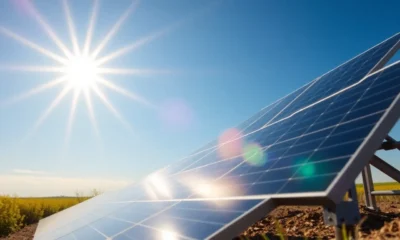

Features
Back-up or Pack-up: how the storage revolution can help keep the lights on
Energy storage is becoming an increasingly important topic of discussion for the renewable sector. An energy storage revolution could completely change the energy industry. Dr Andrew Crossland, senior design engineer at Solarcentury, discusses renewable energy and storage below.
Energy storage is often cited as the missing link for renewables. Solar power plants can charge batteries in the day so that we have a supply of energy after dark. On the windiest days, wind turbines can use storage to hold the energy that we can use to power our homes on the stillest of cold winter days.
However, the reality is that storage remains prohibitively expensive- or so we are lead to believe. Is that true? I don’t think so. And nor is storage a one trick pony – it has the ability to completely revolutionise the world’s energy system – and to understand how, I need to recount the events that occurred on the day of my Grandad’s birthday party.
As we tucked into our roast dinner on party day in May this year, not just one but seven British power stations either broke down or became unavailable. This, together with inaccurate wind forecasts and a breakdown of a subsea connector to France, led to a massive shortfall in electricity. National Grid just didn’t have as much power as it expected. In total, Britain unexpectedly lost around 1,800MW of supply (enough to boil 800,000 Tesco own-brand kettles). National Grid had to find emergency energy sources, so we could continue to enjoy our roast dinner without the lights going out. However, acquiring emergency energy did not come cheap: some power stations were reportedly charging 24x the normal rate –inflating our electricity bills.
So how can we keep the lights on without paying 24x the normal rate of electricity? The best way to keep prices steady is to have a readily available source of backup power which pays for itself by serving multiple functions in the power system. That’s where storage comes in. My proposition is that the same storage that is needed to enable more renewable generation in the electricity system can also be used as backup power, at a fixed and reasonable price.
As coal stations are phased out in many countries around the world (including the UK), we are becoming more reliant on gas power stations to provide the bulk of our electricity. (Biomass is also used to supply electricity to the grid.) These power stations provide reliable power – when they work. But when a big power station fails, the impacts are acute. Renewables are intermittent; however, the impact of a single wind farm failing is miniscule relative to a big power station coming offline.
Storage technology is the perfect partner in both situations: it overcomes the intermittency of renewables and is a vital source of backup power when big power stations go offline.

Storage in the UK
According to the Renewable Energy Association (REA), the UK has 22 large storage installations tied to the electricity system. This is a start, but there is some way to go until there is a sufficient amount of capacity to guard against power outages.
The Energy Storage Network (the industry body for storage) is calling for 2,000MW of new energy storage to be built by 2020. With this amount of backup, the UK could be more comprehensively protected from energy shortfalls which, besides being a massive headache for National Grid, hit consumers where it hurts the most: their wallets. Storage is a money saver: the National Infrastructure Commission recently reported that a smarter energy system with more storage, flexible demand and power connectors to other countries could save the UK up to £8billon every year.
Innovation in storage
Storage technologies are evolving fast. This is driven in part by the need for batteries to power the various devices we now use in our everyday lives, such as phones, electric cars and laptops.
It’s exciting that some of the most innovative storage products are being developed in this country. Although the lithium battery is probably the most famous, flow batteries and thermal storage are hugely promising for some applications. The challenge now for the UK is to properly recognise the value of storage in helping to meet the government’s three core aims: keeping the lights on, reducing our carbon footprint and keeping electricity prices low.
Grandad was born into a coal-centric world. Some 80 years later, the world is moving away from fossil fuels in favour of cleaner, more sustainable energy sources. Without more energy storage, a low carbon world cannot be realised. What is clear is that storage benefits more than the renewable transition – it also improves the reliability, affordability and flexibility of our existing electricity system. This means cleaner air, more consistent prices and more energy independence for the UK. Who wouldn’t want more storage, and who wouldn’t want more right now?


 Environment9 months ago
Environment9 months agoAre Polymer Banknotes: an Eco-Friendly Trend or a Groundswell?

 Environment10 months ago
Environment10 months agoEco-Friendly Home Improvements: Top 7 Upgrades for 2025

 Energy12 months ago
Energy12 months agoA Closer Look at The Rapid Growth of Solar Energy in Ireland

 Energy12 months ago
Energy12 months agoEV Charging Business: It’s About More Than Just Electricity





























